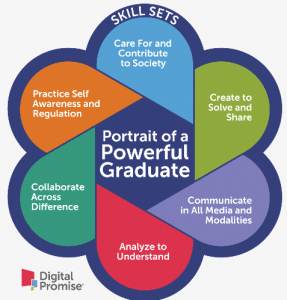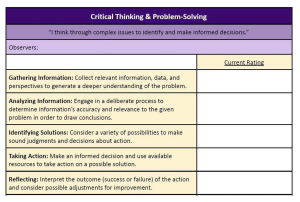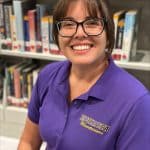Making a Portrait of a Graduate Authentic and Dynamic
CompetencyWorks Blog
This post is part of our Aurora Institute Symposium 2024 series sharing ideas from #Aurora24 sessions.

We’ve all seen those senior year portraits: the head tilt, the stiff smile, the gradient blue background. These portraits can be lovely but tend to capture a very limited view of a young person. People who may write beautiful essays, relish solving complex mathematical problems, skillfully draw other students’ ideas out in class discussions, or spend time on the weekend helping their grandparents. As schools and states continue to draft and implement their own Portraits of a Graduate, they need frameworks to define the dispositions and abilities students should exemplify by graduation. How can we ensure that our frameworks capture the full richness of students’ skills and abilities and we are not left with an elegantly posed Portrait plan that never comes to life?
From a Portrait to Dynamic Classrooms
One challenge many school districts face is how to take the carefully drafted and composed Portrait of a Graduate they have developed and make it actionable and accessible to students, caregivers, and teachers. Skills and dispositions like creativity and critical thinking are challenging to operationalize. One promising direction for enacting Portrait programs is developing integrated learning pathways.
Integrated learning pathways create a competency-based, consistent, complementary, and cumulative learning progression for students to develop skills, mindsets, and dispositions that are represented in Portrait programs. These pathways are essential for ensuring equity for all students in the culture, structure, and pedagogy of schools and education systems. Tools like “I Can” statements that are written for student accessibility at every grade band can help students and educators identify what “collaboration” looks like in a second-grade, seventh-grade, and 11th-grade classroom. Similarly “Look for” documents can help educators and school leaders know what they should see and hear in classrooms that are fostering the skills, mindsets, and dispositions of the Portrait work.
Digital Promise’s Portrait of a Graduate initiative aims to work with teachers and leaders to identify key points for curriculum integration, implement whole-learner pedagogy, and recognize skills in ways that are connected to postsecondary opportunities. Ephrata Area School District in Pennsylvania launched their Life Ready Graduate Initiative in 2015 and serves as a nationwide leader in supporting districts to understand how to implement Portrait of a Graduate in authentic, equitable, and sustainable ways. Ephrata has found that designing instruction that engages students in mastering content competencies while also demonstrating skill and disposition application requires more of educators than other initiatives. To work towards their goals, Ephrata provides increased support, time, and agency to their educators, paired with efforts to strengthen their culture. Digital Promise and Ephrata joined forces this year to understand how to design systems for Learning Pathways, including essential components such as assessment and professional learning.
 Noticing Skills, Mindsets, and Dispositions
Noticing Skills, Mindsets, and Dispositions
One important element of bringing Portraits to life is considering how to assess essential skills, mindsets, and dispositions. Determining how student critical thinking, for instance, will be observed, measured, and reported on is filled with thorny educational brambles. For instance, do we ever really want to tell a kid they struggle with critical thinking or that their creativity is “proficient”?
One reaction to the challenge of assessments is to jump to an assessment vehicle or tool that has shown promise in other educational venues (micro-credentials, standardized assessments, student portfolios, dashboards, etc.). But before districts choose a vehicle for assessing Portrait practices, they must deeply consider what they are counting as evidence of proficiency in Portrait practices and how they are counting this proficiency and sharing with students and families. Portrait assessment must offer authentic opportunities for children to demonstrate the skills and dispositions we are striving to foster and opportunities for them to learn and grow. We strongly agree with principle two of Aurora’s definition of competency-based education: Assessment needs to be a meaningful, positive, and empowering learning experience for students that yields timely, relevant, and actionable evidence. More examples of meaningful assessment systems that can support Portrait of a Graduate are needed. Ephrata Area School District has designed and implemented rubrics for each Life Ready Graduate Knowledge, Skill, and Disposition and integrated them into students’ report cards. Still, designing meaningful opportunities for learning and feedback without placing additional burden on educators’ time remains a challenge. Leaders in Ephrata continue to engage in conversations with students, caregivers, and educators for how and when these skills and dispositions can be noticed and documented.
Ephrata Area School District has designed and implemented rubrics for each Life Ready Graduate Knowledge, Skill, and Disposition and integrated them into students’ report cards. Still, designing meaningful opportunities for learning and feedback without placing additional burden on educators’ time remains a challenge. Leaders in Ephrata continue to engage in conversations with students, caregivers, and educators for how and when these skills and dispositions can be noticed and documented.

Giving Teachers Time, Space, and Resources
As teachers incorporate Portrait practices into their daily classroom routines, there will no doubt be some confusion. Teachers will need time to shift their thinking and their practice. Providing teachers with structures to access resources that support Portrait practices alongside content area learning will go a long way to changing classroom practice, but it will not happen overnight.
To start, focusing on academic standards first has been the norm for the last 30 years of public instruction, which contrasts with the holistic vision conveyed by the Portrait of a Graduate. The shift to skills oriented, competency-based learning expectations has helped many teachers to think in a certain way about their classroom instruction, which is inherently different than how a teacher might develop or notice types of broad, cross cutting skill sets included in most Portrait profiles. Moreover, developing the skills and dispositions included in Portrait of a Graduate profiles requires teachers to design opportunities for students to develop Portrait practices while at the same time ensuring student mastery of content skills and knowledge — the task can seem both impossible and at odds with itself.
Ephrata Area School District has intentionally developed opportunities for teachers to design learning opportunities that connect content area learning to Life Ready Graduate Skills and Dispositions. The coaches in Ephrata emphasize that to make the Portrait a vibrant experience for students and not something that is just hanging on the wall, teachers need to be engaged at several points in the Portrait work. One approach Ephrata is taking this school year is to form a cohort of expert teachers that can create opportunities for teachers to collectively share the new routines they’ve developed related to the Portrait, to observe each other’s classrooms to notice Portrait practices in action, and to reflect on what’s working and what isn’t. Without deeply involving teachers in this ongoing work, the Portrait will not represent daily classroom experiences.
No Easy Solutions!
While it isn’t easy, it’s well worth it for schools and districts to engage in developing integrated learning pathways, meaningful assessment approaches, and powerful professional growth experiences for teachers. It will require school leaders to collaborate, communicate, and think critically and creatively — a great opportunity to model for our students the kinds of skills and dispositions we seek to develop in them.
To get started, we shared our paper Shifting Education with Learning Pathways: Becoming Your Portrait of a Graduate at the 2024 Aurora Institute Symposium. We heard from many districts the challenges they are facing with implementing professional learning that brings about instructional change and how they are seeking approaches that honor teachers’ deep pedagogical knowledge while fostering new teaching approaches that develop Portrait competencies. Districts also shared how they are struggling to define an assessment approach that notices and celebrates student growth, not just measures and reports it. As a next step, Digital Promise is proposing a nationwide cohort of a few districts that would be interested in continuing to explore these questions deeply — looking to untangle the challenging work of taking those Portraits out of the frames and off the walls and turn them into dynamic, nuanced, unique compositions.
Learn More
- Design Considerations for Student Competency Frameworks
- Portrait of a Graduate: A Gateway to Competency-Based Learning
- Competency Frameworks and Content Selection at South Bronx Community Charter
 Kyle Dunbar is a Learning Experience Research at Digital Promise. She has over 20 years experience working in public schools as a social studies teacher and instructional technology coach. At Digital Promise her research projects center around inclusive student-centered learning experiences such as Computational Thinking, Portrait of a Graduate, and Data Literacy.
Kyle Dunbar is a Learning Experience Research at Digital Promise. She has over 20 years experience working in public schools as a social studies teacher and instructional technology coach. At Digital Promise her research projects center around inclusive student-centered learning experiences such as Computational Thinking, Portrait of a Graduate, and Data Literacy.
 Laura Mandell is an Instruction and Engagement Coach for the Ephrata Area School District. She has 7 years of experience in this role, and 10 total years of working with the EASD Portrait of a Graduate. Laura recently earned her doctorate in Curriculum and Instruction, and is passionate about reflection and metacognition. She has represented EASD at various local and national conferences in her time as an Instruction and Engagement Coach, including the Future Focused Schools Conference.
Laura Mandell is an Instruction and Engagement Coach for the Ephrata Area School District. She has 7 years of experience in this role, and 10 total years of working with the EASD Portrait of a Graduate. Laura recently earned her doctorate in Curriculum and Instruction, and is passionate about reflection and metacognition. She has represented EASD at various local and national conferences in her time as an Instruction and Engagement Coach, including the Future Focused Schools Conference.

Brandi Swavely is in her first year with the Ephrata Area School District Instruction and Engagement Coaching team, bringing a wealth of experience to the role. With 17 years in education, she has taught high school biology and middle school science, implemented a 1:1 program as a Technology Integration Specialist, and served as an instructional coach focused on integrating life-ready skills into everyday lessons. Brandi is passionate about the power of play in the classroom and enjoys incorporating it into high school classrooms and adult education.

Kelly Mills is Director of Learning Experience R&D at Digital Promise. She leads nationwide initiatives for the integration of 21st century skills across K-12 learning contexts in authentic, equitable and sustainable ways. Dr. Mills has spearheaded several publications defining complex ideas into actionable strategies such as Computational Thinking, AI Literacy and Portrait of a Graduate.

Anthony Baker is a former anthropologist and educator with experience in social science fieldwork, as well as classroom teaching, regional and state-level education leadership. As Director of Design Strategy at Digital Promise, he designs and leads education innovation programs, with expertise in design facilitation and consulting, curriculum development, and science education.